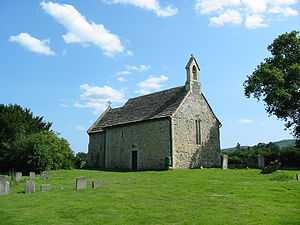Chapel of ease
A chapel of ease (sometimes chapel-of-ease) is a church building other than the parish church, built within the bounds of a parish for the attendance of those who cannot reach the parish church conveniently.[1]
Often such a chapel of ease is deliberately built as such, being more accessible to some parishioners than the main church. A church of this type, the Chapel-of-Ease was built in 1818 by the Church of England (since 1978, called the Anglican Church of Bermuda, an extra-provincial diocese under the Archbishop of Canterbury) on St. David's Island, in the British Overseas Territory of Bermuda to spare St. David's Islanders crossing St. George's Harbour to reach the parish church, St. Peter's, on St. George's Island. [2][3][4] Such a chapel may also exist, for example, when a parish covers several dispersed villages, or a central village together with its satellite hamlet or hamlets. In such a case the parish church will be in the main settlement, with one or more chapels of ease in the subordinate village(s) and/or hamlet(s). An example is the chapel belonging to All Hallows' Parish in Maryland, USA; the chapel was built in Davidsonville from 1860 to 1865 because the parish's "Brick Church" in South River was too far away at 5 miles (8.0 km) distant.[5]
Some chapels of ease are buildings which used to be the main parish church until a larger building was constructed for that purpose. For example, the small village of Norton, Hertfordshire, contains the mediaeval church of St Nicholas, which served it adequately for centuries; but when the large new town of Letchworth was built, partly within the parish, St Nicholas's became too small to serve the increased population. This led to the building of a new main church building for the parish, and St Nicholas's became a chapel of ease.
Chapels of ease are sometimes associated with large manor houses, where they provide a convenient place of worship for the family of the manor, and for the domestic and rural staff of the house and the estate. There are many such chapels in England, for example that at Pedlinge in Kent. An example in the New World is Saint John's Chapel of Ease in Chamcook, New Brunswick, Canada, which was built in the 1840s to support a gentleman's house and the small settlement of shipbuilders, farmers, and grist-mill nearby.[6]

Sometimes an ancient parish church is reduced in status to a chapel of ease due to a shift of population. An example is the churches of St Mary Wiston and All Saints at Buncton in West Sussex. For centuries St Mary's was the parish church (located near to Wiston House and therefore the centre of population), whilst All Saints served the nearby hamlet of Buncton, as a chapel of ease. Today, however, the resident population of Wiston is tiny, whilst Buncton has grown, so that in 2007 the status of the buildings was reversed, with All Saints becoming the parish church, and St Mary's reduced to a chapel of ease.
When two or more existing parishes are combined into a single parish, one or more of the old church buildings may be kept as a chapel of ease. An example can be seen in Palo Alto, California, where, in 1987, the six parishes of the Roman Catholic Diocese of San Jose in California in the city were combined into a single parish, St. Thomas Aquinas Parish.[7] As of 2007, St. Thomas Aquinas Church serves as the parish church, with Our Lady of the Rosary Church and St. Albert the Great Church as chapels of ease.
See also
References
- ↑ Wooster, Lyman. "Chapels of Ease". Heritage Library Foundation, Hilton Head Island, South Carolina, USA. Retrieved 8 February 2012.
- ↑ Anglican Church of Bermuda. Where to Worship. OUR CHURCHES: St. George's Parish
- ↑ The Onion Patch: Chapel of Ease, St.David's Island, Parish of St. George, Bermuda
- ↑ Bermuda Online: Bermuda's St. David's Island. In St. George's Parish but with a unique flavor and character: St. David's Chapel of Ease
- ↑ Enright, Gail. "The History of All Hallows Parish". Retrieved 8 February 2012.
- ↑ Grimmer, E. Muriel (1 August 2000), History of Saint John's Chapel of Ease, Chamcook, New Brunswick, CanadaGenWeb.org, an ancestry.com community, retrieved 8 February 2012
- ↑ "About St. Thomas Aquinas Parish". Retrieved 6 February 2012.